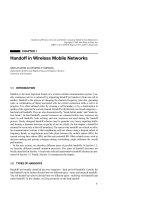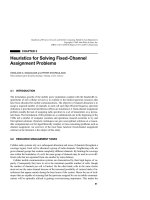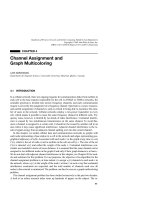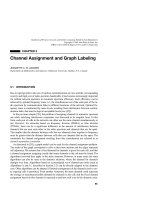Tài liệu Sổ tay của các mạng không dây và điện toán di động P11 ppt
Bạn đang xem bản rút gọn của tài liệu. Xem và tải ngay bản đầy đủ của tài liệu tại đây (158.14 KB, 23 trang )
CHAPTER 11
Data Broadcast
JIANLIANG XU and DIK-LUN LEE
Department of Computer Science, Hong Kong University of Science and Technology
QINGLONG HU
IBM Silicon Valley Laboratory, San Jose, California
WANG-CHIEN LEE
Verizon Laboratories, Waltham, Massachusetts
11.1 INTRODUCTION
We have been witnessing in the past few years the rapid growth of wireless data applica-
tions in the commercial market thanks to the advent of wireless devices, wireless high-
speed networks, and supporting software technologies. We envisage that in the near future,
a large number of mobile users carrying portable devices (e.g., palmtops, laptops, PDAs,
WAP phones, etc.) will be able to access a variety of information from anywhere and at
any time. The types of information that may become accessible wirelessly are boundless
and include news, stock quotes, airline schedules, and weather and traffic information, to
name but a few.
There are two fundamental information delivery methods for wireless data applica-
tions: point-to-point access and broadcast. In point-to-point access, a logical channel is es-
tablished between the client and the server. Queries are submitted to the server and results
are returned to the client in much the same way as in a wired network. In broadcast, data
are sent simultaneously to all users residing in the broadcast area. It is up to the client to
select the data it wants. Later we will see that in a special kind of broadcast system, name-
ly on-demand broadcast, the client can also submit queries to the server so that the data it
wants are guaranteed to be broadcast.
Compared with point-to-point access, broadcast is a more attractive method for several
reasons:
ț A single broadcast of a data item can satisfy all the outstanding requests for that
item simultaneously. As such, broadcast can scale up to an arbitrary number of
users.
ț Mobile wireless environments are characterized by asymmetric communication, i.e.,
the downlink communication capacity is much greater than the uplink communica-
tion capacity. Data broadcast can take advantage of the large downlink capacity
when delivering data to clients.
243
Handbook of Wireless Networks and Mobile Computing, Edited by Ivan Stojmenovic´
Copyright © 2002 John Wiley & Sons, Inc.
ISBNs: 0-471-41902-8 (Paper); 0-471-22456-1 (Electronic)
ț A wireless communication system essentially employs a broadcast component to
deliver information. Thus, data broadcast can be implemented without introducing
any additional cost.
Although point-to-point and broadcast systems share many concerns, such as the need to
improve response time while conserving power and bandwidth consumption, this chapter
focuses on broadcast systems only.
Access efficiency and power conservation are two critical issues in any wireless data
system. Access efficiency concerns how fast a request is satisfied, and power conservation
concerns how to reduce a mobile client’s power consumption when it is accessing the data
it wants. The second issue is important because of the limited battery power on mobile
clients, which ranges from only a few hours to about half a day under continuous use.
Moreover, only a modest improvement in battery capacity of 20–30% can be expected
over the next few years [30]. In the literature, two basic performance metrics, namely ac-
cess time and tune-in time, are used to measure access efficiency and power conservation
for a broadcast system, respectively:
ț Access time is the time elapsed between the moment when a query is issued and the
moment when it is satisfied.
ț Tune-in time is the time a mobile client stays active to receive the requested data
items.
Obviously, broadcasting irrelevant data items increases client access time and, hence,
deteriorates the efficiency of a broadcast system. A broadcast schedule, which determines
what is to be broadcast by the server and when, should be carefully designed. There are
three kinds of broadcast models, namely push-based broadcast, on-demand (or pull-based)
broadcast, and hybrid broadcast. In push-based broadcast [1, 12], the server disseminates
information using a periodic/aperiodic broadcast program (generally without any inter-
vention of clients); in on-demand broadcast [5, 6], the server disseminates information
based on the outstanding requests submitted by clients; in hybrid broadcast [4, 16, 21],
push-based broadcast and on-demand data deliveries are combined to complement each
other. Consequently, there are three kinds of data scheduling methods (i.e., push-based
scheduling, on-demand scheduling, and hybrid scheduling) corresponding to these three
data broadcast models.
In data broadcast, to retrieve a data item, a mobile client has to continuously monitor
the broadcast until the data item of interest arrives. This will consume a lot of battery pow-
er since the client has to remain active during its waiting time. A solution to this problem
is air indexing. The basic idea is that by including auxiliary information about the arrival
times of data items on the broadcast channel, mobile clients are able to predict the arrivals
of their desired data. Thus, they can stay in the power saving mode and tune into the
broadcast channel only when the data items of interest to them arrive. The drawback of
this solution is that broadcast cycles are lengthened due to additional indexing informa-
tion. As such, there is a trade-off between access time and tune-in time. Several indexing
techniques for wireless data broadcast have been introduced to conserve battery power
while maintaining short access latency. Among these techniques, index tree [18] and sig-
nature [22] are two representative methods for indexing broadcast channels.
244
DATA BROADCAST
The rest of this chapter is organized as follows. Various data scheduling techniques are
discussed for push-based, on-demand, and hybrid broadcast models in Section 11.2. In
Section 11.3, air indexing techniques are introduced for single-attribute and multiattribute
queries. Section 11.4 discusses some other issues of wireless data broadcast, such as se-
mantic broadcast, fault-tolerant broadcast, and update handling. Finally, this chapter is
summarized in Section 11.5.
11.2 DATA SCHEDULING
11.2.1 Push-Based Data Scheduling
In push-based data broadcast, the server broadcasts data proactively to all clients accord-
ing to the broadcast program generated by the data scheduling algorithm. The broadcast
program essentially determines the order and frequencies that the data items are broadcast
in. The scheduling algorithm may make use of precompiled access profiles in determining
the broadcast program. In the following, four typical methods for push-based data sched-
uling are described, namely flat broadcast, probabilistic-based broadcast, broadcast disks,
and optimal scheduling.
11.2.1.1 Flat Broadcast
The simplest scheme for data scheduling is flat broadcast. With a flat broadcast program,
all data items are broadcast in a round robin manner. The access time for every data item is
the same, i.e., half of the broadcast cycle. This scheme is simple, but its performance is
poor in terms of average access time when data access probabilities are skewed.
11.2.1.2 Probabilistic-Based Broadcast
To improve performance for skewed data access, the probabilistic-based broadcast [38]
selects an item i for inclusion in the broadcast program with probability f
i
, where f
i
is de-
termined by the access probabilities of the items. The best setting for f
i
is given by the fol-
lowing formula [38]:
f
i
= (11.1)
where q
j
is the access probability for item j, and N is the number of items in the database.
A drawback of the probabilistic-based broadcast approach is that it may have an arbitrari-
ly large access time for a data item. Furthermore, this scheme shows inferior performance
compared to other algorithms for skewed broadcast [38].
11.2.1.3 Broadcast Disks
A hierarchical dissemination architecture, called broadcast disk (Bdisk), was introduced
in [1]. Data items are assigned to different logical disks so that data items in the same
range of access probabilities are grouped on the same disk. Data items are then selected
from the disks for broadcast according to the relative broadcast frequencies assigned to
the disks. This is achieved by further dividing each disk into smaller, equal-size units
͙
q
ෆ
i
ෆ
ᎏ
⌺
N
j=1
͙
q
ෆ
j
ෆ
11.2 DATA SCHEDULING
245
called chunks, broadcasting a chunk from each disk each time, and cycling through all the
chunks sequentially over all the disks. A minor cycle is defined as a subcycle consisting of
one chunk from each disk. Consequently, data items in a minor cycle are repeated only
once. The number of minor cycles in a broadcast cycle equals the least common multiple
(LCM) of the relative broadcast frequencies of the disks. Conceptually, the disks can be
conceived as real physical disks spinning at different speeds, with the faster disks placing
more instances of their data items on the broadcast channel. The algorithm that generates
broadcast disks is given below.
Broadcast Disks Generation Algorithm {
Order the items in decreasing order of access popularities;
Allocate items in the same range of access probabilities on a different disk;
Choose the relative broadcast frequency rel_ freq(i) (in integer) for each disk i;
Split each disk into a number of smaller, equal-size chunks:
Calculate max_chunks as the LCM of the relative frequencies;
Split each disk i into num_chunk(i) = max_chunks/rel_ freq(i) chunks; let C
ij
be the
j th chunk in disk i;
Create the broadcast program by interleaving the chunks of each disk:
for i = 0 to max_chunks – 1
{
for j = 0 to num_disks
broadcast chunk C
j,(i mod num_chunks(j))
;
}
Figure 11.1 illustrates an example in which seven data items are divided into three
groups of similar access probabilities and assigned to three separate disks in the broad-
246
DATA BROADCAST
d e
C
1,1
C
2,1
C
2,2
C
3,1
C
3,2
C
3,3
def
C
1,1
C
2,1
C
3,1
C
1,1
C
2,2
C
3,2
C
1,1
C
2,1
C
3,3
C
1,1
C
2,2
C
3,4
C
3,4
gc
Chunks
bc g
HOT
Data Set
Fast
Disks
Slow
COLD
a
a
a
b
bcdef g
f
A Broadcast Cycle
ag
Minor Cycle
bdaceab fac
D1 D2 D3
Figure 11.1 An Example of a seven-item, three-disk broadcast program.
cast. These three disks are interleaved in a single broadcast cycle. The first disk rotates at
a speed twice as fast as the second one and four times as fast as the slowest disk (the third
disk). The resulting broadcast cycle consists of four minor cycles.
We can observe that the Bdisk method can be used to construct a fine-grained memory
hierarchy such that items of higher popularities are broadcast more frequently by varying
the number of the disks, the size, relative spinning speed, and the assigned data items of
each disk.
11.2.1.4 Optimal Push Scheduling
Optimal broadcast schedules have been studied in [12, 34, 37, 38]. Hameed and Vaidya
[12] discovered a square-root rule for minimizing access latency (note that a similar rule
was proposed in a previous work [38], which considered fixed-size data items only). The
rule states that the minimum overall expected access latency is achieved when the follow-
ing two conditions are met:
1. Instances of each data item are equally spaced on the broadcast channel
2. The spacing s
i
of two consecutive instances of each item i is proportional to the
square root of its length l
i
and inversely proportional to the square root of its access
probability q
i
, i.e.,
s
i
ϰ
͙
l
i
/
ෆ
q
ෆ
i
ෆ
(11.2)
or
s
i
2
= constant (11.3)
Since these two conditions are not always simultaneously achievable, the online sched-
uling algorithm can only approximate the theoretical results. An efficient heuristic scheme
was introduced in [37]. This scheme maintains two variables, B
i
and C
i
, for each item i. B
i
is the earliest time at which the next instance of item i should begin transmission and C
i
=
B
i
+ s
i
. C
i
could be interpreted as the “suggested worse-case completion time” for the next
transmission of item i. Let N be the number of items in the database and T be the current
time. The heuristic online scheduling algorithm is given below.
Heuristic Algorithm for Optimal Push Scheduling {
Calculate optimal spacing s
i
for each item i using Equation (11.2);
Initialize T = 0, B
i
= 0, and C
i
= s
i
, i = 1, 2, ..., N;
While (the system is not terminated){
Determine a set of item S = {i|B
i
Յ T, 1 Յ i Յ N};
Select to broadcast the item i
min
with the min C
i
value in S (break ties arbitrarily);
B
i
min
= C
i
min
;
C
i
min
= B
i
min
+ s
i
min
;
Wait for the completion of transmission for item i
min
;
T = T + l
i
min
;
}
}
q
i
ᎏ
l
i
11.2 DATA SCHEDULING
247
This algorithm has a complexity of O(log N) for each scheduling decision. Simulation
results show that this algorithm performs close to the analytical lower bounds [37].
In [12], a low-overhead, bucket-based scheduling algorithm based on the square root
rule was also provided. In this strategy, the database is partitioned into several buckets,
which are kept as cyclical queues. The algorithm chooses to broadcast the first item in the
bucket for which the expression [T – R(I
m
)]
2
q
m
/l
m
evaluates to the largest value. In the ex-
pression, T is the current time, R(i) is the time at which an instance of item i was most re-
cently transmitted, I
m
is the first item in bucket m, and q
m
and l
m
are average values of q
i
’s
and l
i
’s for the items in bucket m. Note that the expression [T – R(I
m
)]
2
q
m
/l
m
is similar to
equation (11.3). The bucket-based scheduling algorithm is similar to the Bdisk approach,
but in contrast to the Bdisk approach, which has a fixed broadcast schedule, the bucket-
based algorithm schedules the items online. As a result, they differ in the following as-
pects. First, a broadcast program generated using the Bdisk approach is periodic, whereas
the bucket-based algorithm cannot guarantee that. Second, in the bucket-based algorithm,
every broadcast instance is filled up with some data based on the scheduling decision,
whereas the Bdisk approach may create “holes” in its broadcast program. Finally, the
broadcast frequency for each disk is chosen manually in the Bdisk approach, whereas the
broadcast frequency for each item is obtained analytically to achieve the optimal overall
system performance in the bucket-based algorithm. Regrettably, no study has been carried
out to compare their performance.
In a separate study [33], the broadcast system was formulated as a deterministic
Markov decision process (MDP). Su and Tassiulas [33] proposed a class of algorithms
called priority index policies with length (PIPWL-
␥
), which broadcast the item with the
largest (p
i
/l
i
)
␥
[T – R(i)], where the parameters are defined as above. In the simulation ex-
periments, PIPWL-0.5 showed a better performance than the other settings did.
11.2.2 On-Demand Data Scheduling
As can be seen, push-based wireless data broadcasts are not tailored to a particular user’s
needs but rather satisfy the needs of the majority. Further, push-based broadcasts are not
scalable to a large database size and react slowly to workload changes. To alleviate these
problems, many recent research studies on wireless data dissemination have proposed us-
ing on-demand data broadcast (e.g., [5, 6, 13, 34]).
A wireless on-demand broadcast system supports both broadcast and on-demand ser-
vices through a broadcast channel and a low-bandwidth uplink channel. The uplink chan-
nel can be a wired or a wireless link. When a client needs a data item, it sends to the serv-
er an on-demand request for the item through the uplink. Client requests are queued up (if
necessary) at the server upon arrival. The server repeatedly chooses an item from among
the outstanding requests, broadcasts it over the broadcast channel, and removes the associ-
ated request(s) from the queue. The clients monitor the broadcast channel and retrieve the
item(s) they require.
The data scheduling algorithm in on-demand broadcast determines which request to
service from its queue of waiting requests at every broadcast instance. In the following,
on-demand scheduling techniques for fixed-size items and variable-size items, and
energy-efficient on-demand scheduling are described.
248
DATA BROADCAST
11.2.2.1 On-Demand Scheduling for Equal-Size Items
Early studies on on-demand scheduling considered only equal-size data items. The aver-
age access time performance was used as the optimization objective. In [11] (also de-
scribed in [38]), three scheduling algorithms were proposed and compared to the FCFS al-
gorithm:
1. First-Come-First-Served (FCFS): Data items are broadcast in the order of their re-
quests. This scheme is simple, but it has a poor average access performance for
skewed data requests.
2. Most Requests First (MRF): The data item with the largest number of pending re-
quests is broadcast first; ties are broken in an arbitrary manner.
3. MRF Low (MRFL) is essentially the same as MRF, but it breaks ties in favor of the
item with the lowest request probability.
4. Longest Wait First (LWF): The data item with the largest total waiting time, i.e., the
sum of the time that all pending requests for the item have been waiting, is chosen
for broadcast.
Numerical results presented in [11] yield the following observations. When the load is
light, the average access time is insensitive to the scheduling algorithm used. This is ex-
pected because few scheduling decisions are required in this case. As the load increases,
MRF yields the best access time performance when request probabilities on the items are
equal. When request probabilities follow the Zipf distribution [42], LWF has the best per-
formance and MRFL is close to LWF. However, LWF is not a practical algorithm for a
large system. This is because at each scheduling decision, it needs to recalculate the total
accumulated waiting time for every item with pending requests in order to decide which
one to broadcast. Thus, MRFL was suggested as a low-overhead replacement of LWF in
[11].
However, it was observed in [6] that MRFL has a performance as poor as MRF for a
large database system. This is because, for large databases, the opportunity for tie-break-
ing diminishes and thus MRFL degenerates to MRF. Consequently, a low-overhead and
scalable approach called R × W was proposed in [6]. The R × W algorithm schedules for
the next broadcast the item with the maximal R × W value, where R is the number of out-
standing requests for that item and W is the amount of time that the oldest of those re-
quests has been waiting for. Thus, R × W broadcasts an item either because it is very pop-
ular or because there is at least one request that has waited for a long time. The method
could be implemented inexpensively by maintaining the outstanding requests in two sort-
ed orders, one ordered by R values and the other ordered by W values. In order to avoid ex-
haustive search of the service queue, a pruning technique was proposed to find the maxi-
mal R × W value. Simulation results show that the performance of the R × W is close to
LWF, meaning that it is a good alternative for LWF when scheduling complexity is a major
concern.
To further improve scheduling overheads, a parameterized algorithm was developed
based on R × W. The parameterized R × W algorithm selects the first item it encounters in
the searching process whose R × W value is greater than or equal to
␣
× threshold, where
11.2 DATA SCHEDULING
249
␣
is a system parameter and threshold is the running average of the R × W values of the re-
quests that have been serviced. Varying the
␣
parameter can adjust the performance trade-
off between access time and scheduling overhead. For example, in the extreme case where
␣
= 0, this scheme selects the top item either in the R list or in the W list; it has the least
scheduling complexity but its access time performance may not be very good. With larger
␣
values, the access time performance can be improved, but the scheduling complexity is
increased as well.
11.2.2.2 On-Demand Scheduling for Variable-Size Items
On-demand scheduling for applications with variable data item sizes was studied in [5].
To evaluate the performance for items of different sizes, a new performance metric called
stretch was used. Stretch is the ratio of the access time of a request to its service time,
where the service time is the time needed to complete the request if it were the only job in
the system.
Compared with access time, stretch is believed to be a more reasonable metric for
items of variable sizes since it takes into consideration the size (i.e., service time) of a re-
quested data item. Based on the stretch metric, four different algorithms have been investi-
gated [5]. All four algorithms considered are preemptive in the sense that the scheduling
decision is reevaluated after broadcasting any page of a data item (it is assumed that a data
item consists of one or more pages that have a fixed size and are broadcast together in a
single data transmission).
1. Preemptive Longest Wait First (PLWF): This is the preemptive version of the LWF
algorithm. The LWF criterion is applied to select the subsequent data item to be
broadcast.
2. Shortest Remaining Time First (SRTF): The data item with the shortest remaining
time is selected.
3. Longest Total Stretch First (LTSF): The data item which has the largest total cur-
rent stretch is chosen for broadcast. Here, the current stretch of a pending request
is the ratio of the time the request has been in the system thus far to its service
time.
4. MAX Algorithm: A deadline is assigned to each arriving request, and it schedules
for the next broadcast the item with the earliest deadline. In computing the deadline
for a request, the following formula is used:
deadline = arrival time + service time × S
max
(11.4)
where S
max
is the maximum stretch value of the individual requests for the last satis-
fied requests in a history window. To reduce computational complexity, once a
deadline is set for a request, this value does not change even if S
max
is updated be-
fore the request is serviced.
The trace-based performance study carried out in [5] indicates that none of these
schemes is superior to the others in all cases. Their performance really depends on the sys-
250
DATA BROADCAST
tem settings. Overall, the MAX scheme, with a simple implementation, performs quite
well in both the worst and average cases in access time and stretch measures.
11.2.2.3 Energy-Efficient Scheduling
Datta et al. [10] took into consideration the energy saving issue in on-demand broad-
casts. The proposed algorithms broadcast the requested data items in batches, using an
existing indexing technique [18] (refer to Section 11.3 for details) to index the data
items in the current broadcast cycle. In this way, a mobile client may tune into a small
portion of the broadcast instead of monitoring the broadcast channel until the desired
data arrives. Thus, the proposed method is energy efficient. The data scheduling is based
on a priority formula:
Priority = IF
ASP
× PF (11.5)
where IF (ignore factor) denotes the number of times that the particular item has not been
included in a broadcast cycle, PF (popularity factor) is the number of requests for this
item, and ASP (adaptive scaling factor) is a factor that weights the significance of IF and
PF. Two sets of broadcast protocols, namely constant broadcast size (CBS) and variable
broadcast size (VBS), were investigated in [10]. The CBS strategy broadcasts data items
in decreasing order of the priority values until the fixed broadcast size is exhausted. The
VBS strategy broadcasts all data items with positive priority values. Simulation results
show that the VBS protocol outperforms the CBS protocol at light loads, whereas at heavy
loads the CBS protocol predominates.
11.2.3 Hybrid Data Scheduling
Push-based data broadcast cannot adapt well to a large database and a dynamic environ-
ment. On-demand data broadcast can overcome these problems. However, it has two main
disadvantages: i) more uplink messages are issued by mobile clients, thereby adding de-
mand on the scarce uplink bandwidth and consuming more battery power on mobile
clients; ii) if the uplink channel is congested, the access latency will become extremely
high. A promising approach, called hybrid broadcast, is to combine push-based and on-de-
mand techniques so that they can complement each other. In the design of a hybrid sys-
tem, three issues need to be considered:
1. Access method from a client’s point of view, i.e., where to obtain the requested data
and how
2. Bandwidth/channel allocation between the push-based and on-demand deliveries
3. Assignment of a data item to either push-based broadcast, on-demand broadcast or
both
Concerning these three issues, there are different proposals for hybrid broadcast in the lit-
erature. In the following, we introduce the techniques for balancing push and pull and
adaptive hybrid broadcast.
11.2 DATA SCHEDULING
251









